Key Takeaways
- Discover the leading corporate wellness software of 2025, featuring advanced tools for mental, physical, and financial employee well-being.
- Understand key trends like AI personalization, inclusive programs, and seamless HR integration shaping the future of workplace wellness.
- Learn how to select the best platform based on organizational size, budget, and specific wellness priorities for maximum employee engagement.
The landscape of corporate wellness software is undergoing rapid transformation in 2025, driven by the increasing recognition of employee well-being as a critical component of organizational success. As companies strive to create healthier, more engaged, and productive workforces, the demand for advanced wellness platforms that address diverse employee needs has never been greater. This in-depth analysis explores the top 11 corporate wellness software solutions that are shaping the industry in 2025, highlighting their distinctive features, technological innovations, and strategic benefits.

Corporate wellness programs have evolved beyond traditional fitness challenges and health screenings to encompass a holistic approach integrating physical health, mental well-being, financial wellness, and social engagement. Organizations of all sizes—from small businesses to multinational corporations—are seeking software that offers seamless integration with existing HR systems, robust data analytics, and personalized employee experiences. The emphasis on customizable platforms that can adapt to varied workforce demographics and preferences has intensified, making it essential for employers to carefully evaluate available solutions.
This comprehensive review delves into the capabilities of each leading platform, including their use of gamification, wearable technology integration, AI-driven insights, and mental health support. Additionally, the analysis considers critical factors such as pricing structures, scalability, global reach, and user satisfaction ratings. As companies navigate a competitive talent market, investing in the right corporate wellness software not only enhances employee health outcomes but also drives retention, reduces healthcare costs, and fosters a positive organizational culture.
By examining the latest trends and technologies embedded in these top wellness platforms, this guide equips HR professionals, wellness coordinators, and business leaders with the knowledge necessary to make informed decisions. Understanding the strengths and unique offerings of each solution will enable organizations to implement effective wellness strategies that align with their specific goals and workforce dynamics in 2025 and beyond.
Before we venture further into this article, we would like to share who we are and what we do.
About 9cv9
9cv9 is a business tech startup based in Singapore and Asia, with a strong presence all over the world.
With over nine years of startup and business experience, and being highly involved in connecting with thousands of companies and startups, the 9cv9 team has listed some important learning points in this overview of The Top 11 Corporate Wellness Software in 2025.
If your company needs recruitment and headhunting services to hire top-quality employees, you can use 9cv9 headhunting and recruitment services to hire top talents and candidates. Find out more here, or send over an email to [email protected].
Or just post 1 free job posting here at 9cv9 Hiring Portal in under 10 minutes.
Top 11 Corporate Wellness Software in 2025: An In-Depth Analysis
- Wellable Wellness Platform
- Vantage Fit
- Headspace for Work
- Forma
- Nectar
- YuMuuv
- Wellness360
- Sprout (Telus Health Platform)
- Limeade
- Virgin Pulse
- Microsoft Viva Insights
1. Wellable Wellness Platform
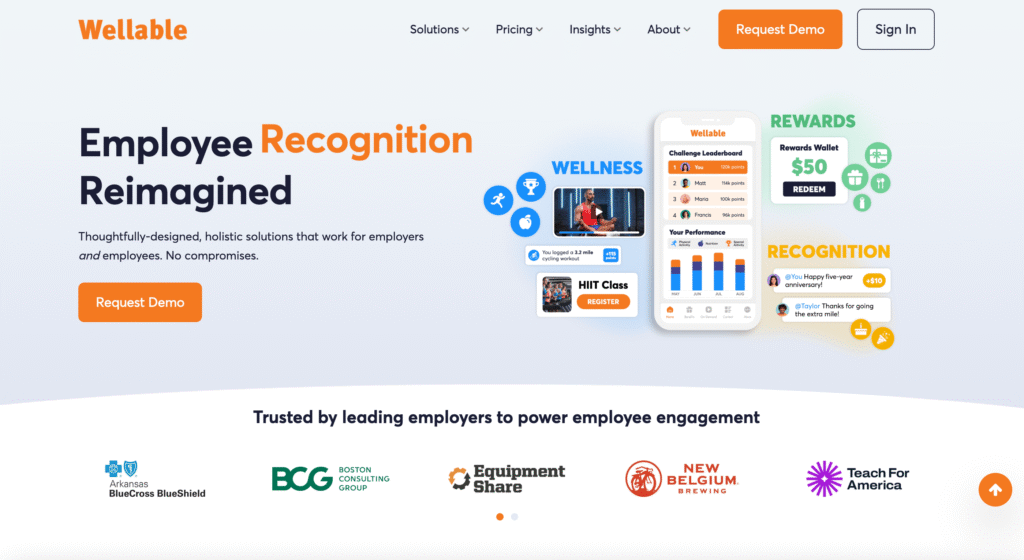
Wellable Wellness Platform stands out as one of the premier corporate wellness software solutions in 2025, widely recognized for its comprehensive and adaptable approach to fostering employee health and engagement. Its consistent high rankings and extensive positive feedback reflect its effectiveness in driving wellness culture across organizations of varying sizes.
Customization and Engagement Features
- Enables creation and participation in fully customizable wellness challenges tailored to organizational goals and employee interests.
- Facilitates reward mechanisms for healthy behaviors, enhancing motivation and sustained engagement.
- Provides seamless progress tracking to maintain user accountability and visibility into wellness achievements.
Holistic Wellness Services
- Extends beyond digital activity tracking to include live and recorded fitness classes, health webinars, and personalized health coaching.
- Supports clinical event verification, ensuring accurate documentation and validation of health-related activities.
- Offers benefits navigation tools that simplify employees’ understanding and utilization of available health benefits, promoting better health decisions.
Integration and Community Building
- Compatible with major fitness trackers such as Fitbit and Apple Watch, enabling effortless syncing of activity data for real-time monitoring.
- Includes a dedicated community forum that fosters peer support, social interaction, and encouragement among participants.
User Experience and Satisfaction Metrics
- Achieves an impressive 4.7 out of 5 rating on Gartner, based on 42 user reviews.
- Maintains an equally strong 4.7 out of 5 score on G2, with over 700 user ratings indicating widespread approval.
- Secures average app ratings of 4.3 stars on both iOS and Android platforms, confirming mobile usability and user satisfaction.
- Praised for its intuitive interface, engaging wellness activities, and responsive customer service.
Client Profile and Market Presence
- Primarily serves mid-market organizations (59%) and large enterprises (30%), demonstrating its scalability and robustness for complex corporate environments.
- Flexible enough to cater to various organizational sizes and wellness program scopes.
Pricing Structure
- Self-directed plans commence at $75 monthly, ideal for smaller-scale implementations.
- Essentials plan priced at $625 per month, equating to $1.25 per user monthly, suitable for medium-sized teams.
- Pro plan offered at $1,125 per month or $2.25 per user monthly, designed for comprehensive enterprise deployments.
- Single challenge event pricing ranges between $625 and $5,000, accommodating short-term or targeted wellness initiatives.
Strengths and Differentiators
- Holistic approach to employee well-being integrating physical, mental, and social health elements.
- Highly configurable platform allowing organizations to tailor wellness experiences to unique workforce needs.
- Consistently high user satisfaction across multiple review platforms reflecting alignment with client expectations.
- Diverse pricing options support a wide spectrum of organizational budgets and engagement strategies.
- Demonstrated scalability to meet the demands of mid-sized to large enterprises.
Summary Matrix: Wellable Wellness Platform Highlights
| Aspect | Details |
|---|---|
| Customization | Fully customizable challenges and rewards |
| Holistic Services | Fitness classes, webinars, health coaching |
| Integration | Fitbit, Apple Watch |
| Community Features | Peer support forums |
| User Ratings | Gartner 4.7/5, G2 4.7/5, App Store 4.3/5 |
| Target Market | Mid-market (59%), Enterprise (30%) |
| Pricing Range | $75 to $1,125/month plus single events |
| Unique Selling Points | Holistic wellness, scalability, flexible pricing |
In conclusion, Wellable Wellness Platform’s advanced functionality, exceptional user experience, and adaptable pricing make it a top-tier choice for corporate wellness programs in 2025. Its ability to combine comprehensive wellness offerings with a user-centric design and scalable infrastructure clearly positions it among the elite software solutions in this competitive market.
2. Vantage Fit
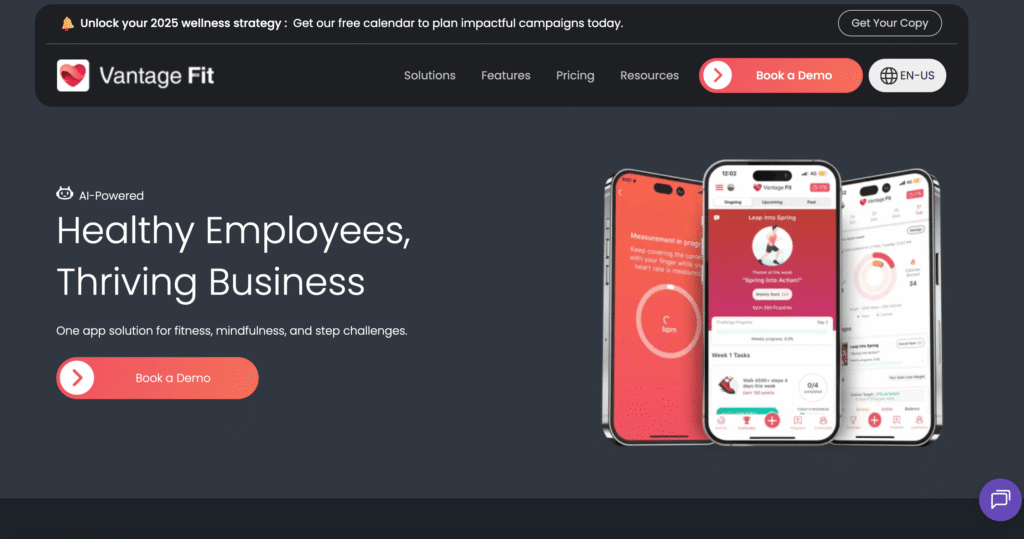
Vantage Fit by Vantage Circle has established itself as one of the foremost corporate wellness software platforms in 2025. It is widely acknowledged for its extensive and dynamic suite of wellness tools, purpose-built to elevate employee engagement through a sophisticated blend of fitness challenges, rewards, and gamification. The platform’s holistic approach to employee well-being and its scalable architecture make it a preferred choice for organizations seeking to foster healthier, more motivated workforces.
Customization and Engagement Features
- Offers an extensive range of health and fitness challenges tailored to accommodate varying fitness levels and personal interests, ensuring inclusivity across diverse employee populations.
- Implements a compelling rewards system that incentivizes consistent tracking and achievement of wellness goals, a core strategy proven to drive sustained employee participation.
- Includes team-based challenges supported by real-time leaderboards that promote healthy competition and collective motivation.
- Provides customizable trophies and badges to celebrate milestones and enhance the gamification experience.
Comprehensive Health Tracking Capabilities
- Enables seamless tracking of key physical activities such as walking, running, and various workout regimens, ensuring detailed monitoring of employee fitness.
- Integrates effortlessly with leading fitness devices including Fitbit, Apple Watch, and Garmin, enabling accurate and real-time data synchronization.
- Features advanced wellness tools such as a mood tracker, heart rate monitoring through smartphone camera technology, nutrition tracking, calorie counting, and a BMI calculator, contributing to a thorough and multi-dimensional assessment of employee health.
User Satisfaction and Performance Metrics
- Achieves a stellar rating of 4.8 out of 5 on Gartner, supported by 58 user reviews, with 81% of ratings awarding it the highest five-star score.
- Maintains an average G2 rating of 4.5 out of 5, reflecting positive reception from a broad user base.
- Scores an 8.7 out of 10 on TrustRadius, underscoring consistent user satisfaction across multiple review platforms.
- Users consistently commend the platform’s engaging rewards system, robust wellness feature set, gamification elements, intuitive user interface, and reliable device integrations.
- Some users have reported sporadic syncing challenges and minor data accuracy issues, although these are not pervasive.
Pricing Models and Market Adaptability
- Offers a one-time challenge package priced at $1,500, allowing organizations to implement focused, short-term wellness initiatives.
- Annual subscription plans begin at $4,500, with an additional initial setup fee of $500, providing a comprehensive wellness program framework.
- The enterprise-level annual plan is available at $7,500, catering to larger organizations with more complex wellness program requirements.
- Pricing structure delivers flexibility to accommodate varying organizational sizes and wellness engagement strategies.
Distinctive Advantages and Market Positioning
- Centers its engagement strategy on an effective rewards and gamification system, uniquely motivating employees through tangible incentives.
- Provides a wide array of health metrics tracking, integrating physical, mental, and nutritional health parameters to present a holistic wellness profile.
- Exhibits broad compatibility with leading fitness trackers, ensuring accurate data capture and seamless user experience.
- Supports scalable deployment, making it suitable for mid-sized companies to large enterprises.
- Features smooth integration with payroll systems, enhancing administrative efficiency and program management.
Summary Matrix: Vantage Fit Key Attributes
| Feature | Description |
|---|---|
| Wellness Challenges | Customizable, multi-level fitness and health challenges |
| Engagement Strategy | Rewards-based gamification with trophies and badges |
| Health Metrics Tracked | Physical activity, mood, heart rate, nutrition, BMI, calories |
| Device Integrations | Fitbit, Apple Watch, Garmin |
| User Ratings | Gartner 4.8/5, G2 4.5/5, TrustRadius 8.7/10 |
| Pricing Options | One-time challenge $1,500; Annual $4,500+ setup; Enterprise $7,500 |
| Target Audience | Mid-market to large enterprises |
| Unique Selling Points | Strong rewards focus, comprehensive tracking, scalable solutions |
In conclusion, Vantage Fit’s robust combination of engaging gamification, broad health monitoring capabilities, and flexible pricing schemes solidify its reputation as a top corporate wellness software platform in 2025. Its proven ability to motivate employees through rewards, coupled with seamless integration options and scalable infrastructure, positions it as a strategic asset for organizations aiming to enhance workforce health and productivity.
3. Headspace for Work
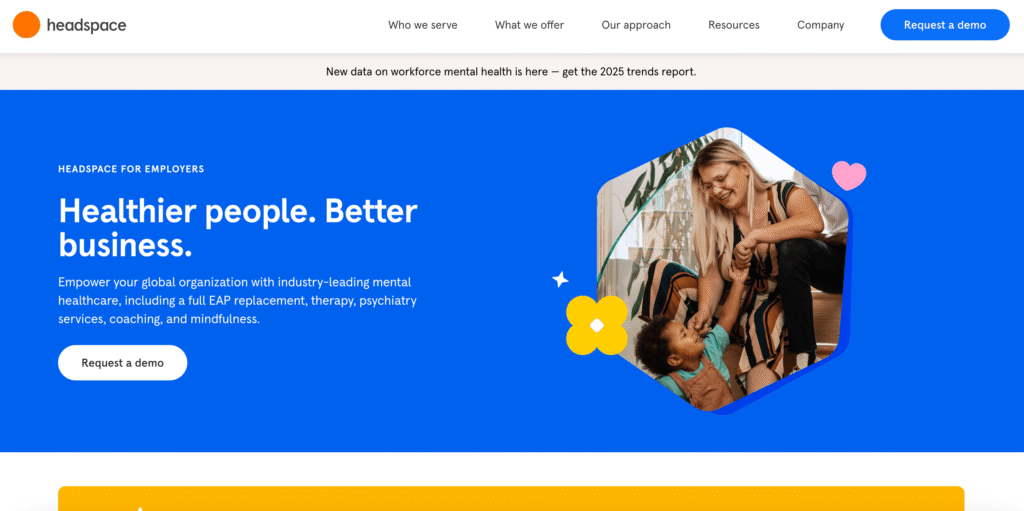
Headspace for Work has distinguished itself as a premier corporate wellness software solution in 2025, primarily due to its targeted focus on mental health and mindfulness within the workplace. Renowned for delivering a scientifically grounded and user-centric platform, it offers an extensive range of tools and resources designed to support employees’ mental well-being, thereby fostering healthier, more resilient workforces.
Comprehensive Mental Health and Mindfulness Resources
- Provides an expansive library of guided meditations and mindfulness exercises tailored to alleviate stress and enhance emotional regulation.
- Features specialized sleep aids, including sleepcasts, designed to improve sleep quality, a critical component of overall employee wellness.
- Incorporates focus-enhancing music to boost concentration and productivity during work hours.
- Offers content specifically curated for workplace challenges, addressing issues such as stress management, burnout prevention, and productivity enhancement.
Clinical Validation and Extended Support Services
- Employs evidence-based practices and clinically validated content to ensure effectiveness and credibility.
- Provides access to licensed therapy and psychiatry services in the United States, positioning itself as a comprehensive Employee Assistance Program (EAP) replacement.
- Delivers phone and critical incident support, offering immediate assistance in crisis situations, which enhances organizational resilience.
Engagement and Administrative Capabilities
- Integrates robust engagement strategies to maintain high levels of employee participation and sustained usage.
- Equips organizations with administrative tools that track employee involvement, enabling measurement of program effectiveness and ROI.
- Facilitates data-driven insights allowing employers to identify trends in mental well-being and tailor interventions accordingly.
User Feedback and Impact Metrics
- Earns a strong user rating of 4.6 out of 5 on G2, reflecting widespread satisfaction and trust in the platform’s capabilities.
- Demonstrates significant positive outcomes, with studies indicating a 32% reduction in employee stress levels within 30 days of usage.
- Reports a 19% decrease in anxiety and a 29% decline in depression symptoms after eight weeks, highlighting its substantial impact on mental health.
- Praised for its intuitive interface, practical effectiveness in stress management, and its contribution to fostering a positive workplace culture.
Limitations and Areas for Improvement
- Some users report limited multilingual support, which may affect accessibility in diverse global organizations.
- Predominantly relies on pre-recorded content, potentially reducing the immediacy of personalized engagement for certain users.
Pricing Structure and Accessibility
- Offers a free trial, allowing organizations to evaluate the platform’s suitability before committing.
- Pricing begins at $7.50 per user per month, making it accessible for a range of business sizes.
- Annual pricing for small businesses with 50 or more employees ranges from $56.04 to $69.99 per employee, offering scalable options for growing enterprises.
- Individual subscriptions are also available to accommodate personal mental wellness needs outside the corporate framework.
Distinctive Advantages and Market Positioning
- Specialized focus on mental health and mindfulness distinguishes it within the broader corporate wellness software landscape.
- Backed by rigorous scientific research and clinical validation, enhancing its credibility and appeal to health-conscious organizations.
- Comprehensive suite of mental health support services, including therapy and psychiatry, positions it as a holistic EAP alternative.
- High user engagement rates driven by relevant content and interactive features reinforce its effectiveness.
- Addresses the increasing demand for mental health prioritization in the workplace, aligning with contemporary wellness trends.
Summary Matrix: Headspace for Work Core Attributes
| Attribute | Description |
|---|---|
| Mental Health Focus | Mindfulness, stress reduction, sleep improvement |
| Clinical Support | Therapy, psychiatry, critical incident phone support |
| Engagement Tools | Guided meditations, focus music, workplace-specific content |
| User Ratings | G2 4.6/5 |
| Impact Metrics | 32% stress reduction (30 days), 19% anxiety, 29% depression (8 weeks) |
| Pricing | Starting at $7.50/user/month; Small business annual $56.04-$69.99 |
| Accessibility | Free trial available; Individual and corporate plans |
| Limitations | Limited multilingual content, primarily pre-recorded |
In summary, Headspace for Work’s specialization in mental well-being, combined with clinically validated content and extensive support services, makes it an indispensable tool for organizations striving to cultivate resilient and mentally healthy work environments in 2025. Its demonstrated effectiveness in reducing stress and mental health symptoms, alongside flexible pricing and scalable features, firmly establishes it among the top corporate wellness software solutions in the contemporary marketplace.
4. Forma
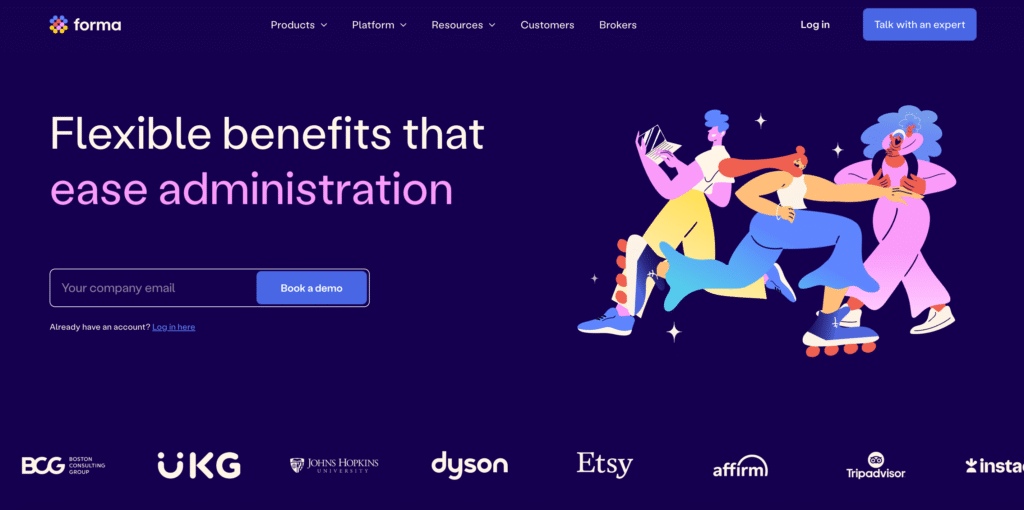
Forma, formerly recognized as Twic, has emerged as a prominent leader in the corporate wellness software landscape in 2025 by redefining employee benefits through unparalleled customization and flexibility. Its core strength lies in empowering employees with control over their wellness and lifestyle benefits, thereby fostering a more inclusive, personalized, and engaging wellness experience that aligns with contemporary workforce expectations.
Customizable Benefit Accounts and Employee Empowerment
- Offers an extensive array of flexible spending accounts tailored to diverse employee needs, including Lifestyle Spending Accounts (LSAs), Health Savings Accounts (HSAs), Flexible Spending Accounts (FSAs), Health Reimbursement Arrangements (HRAs), and commuter benefits.
- Empowers employees to curate their own wellness portfolios, selecting benefits that best align with their individual lifestyles and health priorities.
- Promotes inclusivity by accommodating a broad spectrum of wellness preferences and needs, thereby increasing employee satisfaction and engagement.
Comprehensive Wellness Marketplace and Payment Solutions
- Provides access to the Forma Store, a carefully curated marketplace featuring a wide variety of wellness and lifestyle products, facilitating convenient and meaningful benefit utilization.
- Integrates the Forma Visa debit card, enabling direct and effortless purchases from the wellness marketplace or approved vendors, streamlining employee spending.
- Simplifies claims administration with an efficient, user-friendly process that minimizes administrative burden for both employees and HR teams.
Robust Integration and Global Compliance
- Seamlessly integrates with existing HR Information Systems (HRIS), ensuring smooth data flow and operational efficiency.
- Designed to support multinational organizations, offering compliance features that accommodate multi-region regulatory requirements, thus ensuring adherence to diverse international standards.
User Experience, Satisfaction, and Retention
- Commands an exceptional G2 rating of 4.8 out of 5, reflecting widespread user approval and trust in the platform’s capabilities.
- Achieves a striking 98% customer retention rate, indicative of long-term client satisfaction and loyalty.
- Maintains a strong Net Promoter Score (NPS) of 75 and a Customer Satisfaction (CSAT) rating of 98%, underscoring high user advocacy and contentment.
- Receives consistent praise for its ease of use, extensive customization options, personalized perks, streamlined administration, and strong support for global teams.
- Noted areas for improvement include occasional delays in reimbursement processing, although these instances remain infrequent and typically addressed promptly.
Pricing Structure and Investment Insights
- Adopts a customizable pricing model tailored to the specific needs and scale of each organization, promoting affordability and scalability.
- Market data indicates an average annual cost around $21,000, with reported ranges between approximately $3,667 and $19,834, reflecting flexible budgeting options for diverse business sizes and requirements.
Distinctive Value Propositions and Market Position
- Centralizes flexible benefits management, positioning itself as a pioneer in personalizing employee wellness investments.
- Enables comprehensive administration across multiple types of spending accounts, consolidating wellness and lifestyle benefits into a single platform.
- Exhibits industry-leading customer satisfaction and retention metrics, highlighting its reliability and value.
- Built-in global compliance capabilities render it a preferred solution for multinational enterprises seeking unified benefits management across regions.
- Aligns strategically with the growing corporate wellness trend towards employee choice and personalization, enhancing workforce well-being and engagement.
Summary Matrix: Forma Wellness Platform Attributes
| Feature | Description |
|---|---|
| Spending Account Types | LSAs, HSAs, FSAs, HRAs, commuter benefits |
| Marketplace | Curated Forma Store with wellness and lifestyle products |
| Payment Solutions | Forma Visa debit card for direct purchases |
| Integration | HRIS integration, multi-region compliance |
| User Ratings | G2 4.8/5, 98% retention, NPS 75, CSAT 98% |
| Pricing | Custom pricing; Average $21,000/year, range $3,667-$19,834 |
| Target Market | Mid-sized to global enterprises |
| Unique Selling Points | Flexible benefit choices, global compliance, high retention |
In conclusion, Forma’s innovative approach to corporate wellness through flexible benefit accounts and personalized perks solidifies its status as a top-tier wellness software in 2025. Its ability to combine robust customization, seamless integration, and exceptional customer satisfaction makes it a strategic asset for organizations committed to fostering inclusive, employee-centered wellness programs that resonate with today’s diverse workforce.
5. Nectar
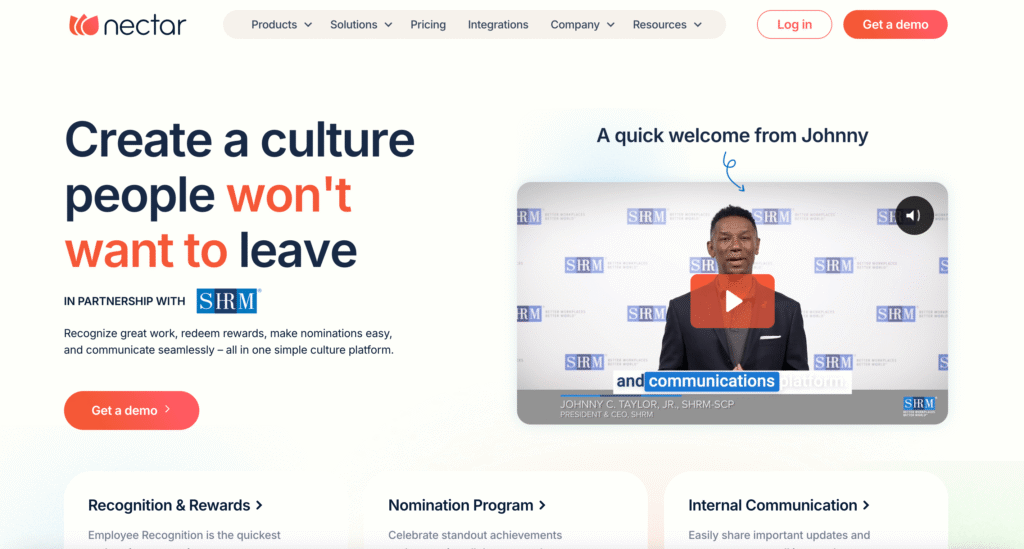
Nectar has firmly positioned itself among the elite corporate wellness software solutions in 2025, largely due to its focused commitment to enhancing employee recognition and rewards as essential drivers of workplace engagement and culture. By combining comprehensive recognition tools with wellness challenges and mental health support, Nectar cultivates a positive, appreciative work environment that fosters both individual well-being and organizational cohesion.
Employee Recognition and Rewards System
- Facilitates a robust recognition framework that supports both peer-to-peer and manager-to-employee acknowledgments, encouraging a culture of appreciation and mutual respect.
- Utilizes an intuitive points-based system where employees accumulate points through various achievements, which can then be redeemed for an extensive catalog of rewards including gift cards, branded merchandise, and charitable donations, thereby incentivizing positive behaviors and participation.
- Incorporates nomination programs that highlight outstanding contributions, further promoting employee motivation and morale.
Wellness and Mental Health Support
- Integrates wellness challenges designed to promote healthy habits and enhance physical and mental well-being.
- Provides dedicated mental health resources aimed at supporting employees’ psychological resilience and stress management.
Communication and Integration Capabilities
- Enhances internal communication through built-in tools that streamline recognition messaging and feedback.
- Seamlessly integrates with leading collaboration platforms such as Slack and Microsoft Teams, enabling real-time recognition and effortless embedding into daily workflows.
- Features an AI-powered writing assistant that crafts personalized recognition messages, adding a thoughtful, human touch to acknowledgments and improving engagement.
User Satisfaction and Industry Recognition
- Achieves an impressive 4.7 out of 5 rating on G2, based on over 6,600 user reviews, reflecting broad acceptance and satisfaction.
- Maintains a 4.8 out of 5 rating on Capterra, and an outstanding 9.3 out of 10 score on TrustPilot, showcasing consistent user endorsement.
- Scores 4.6 on B2B Reviews, reinforcing its status as a trusted solution in the business community.
- Users frequently commend Nectar for its user-friendly interface, efficacy in fostering appreciation, and the positive impact its recognition system has on workplace relationships.
- Some feedback points to limitations in the number of points employees can earn and the relative depth of integration with other HR systems compared to competing platforms.
Pricing Structure and Accessibility
- Offers competitive pricing beginning at $2.75 per user per month, making it accessible for organizations of varied sizes and budgets.
- Provides a free trial to allow potential clients to assess the platform’s suitability prior to commitment.
- Premium plans are available, priced between $1 and $3 per user per month, catering to diverse organizational needs and feature requirements.
- Annual pricing data indicates a range from approximately $589 to $7,280, offering scalable investment options aligned with organizational size.
Distinctive Advantages and Market Positioning
- Places employee recognition and rewards at the core of its engagement strategy, uniquely positioning itself to influence workplace culture positively.
- Combines wellness challenges with mental health support to offer a well-rounded approach to employee well-being beyond simple recognition.
- Ensures smooth adoption and usage through deep integration with popular collaboration tools widely used in modern workplaces.
- Delivers a flexible and cost-effective pricing model that supports organizations from startups to large enterprises.
- Consistently high ratings across major review platforms underline the vital role of recognition in driving employee engagement and wellness outcomes.
Summary Matrix: Nectar Corporate Wellness Platform Overview
| Feature | Description |
|---|---|
| Recognition System | Peer-to-peer and manager-to-employee acknowledgments; points-based rewards |
| Wellness Features | Wellness challenges; mental health support |
| Integration | Slack, Microsoft Teams, AI writing assistant |
| User Ratings | G2 4.7/5, Capterra 4.8/5, TrustPilot 9.3/10, B2B Reviews 4.6 |
| Pricing | Starts at $2.75/user/month; Premium $1–$3/user/month; Free trial available |
| Target Market | Small to large organizations |
| Unique Selling Points | Strong recognition focus; comprehensive engagement; flexible pricing |
In summary, Nectar’s sophisticated blend of employee recognition, rewards, wellness initiatives, and seamless technological integrations establishes it as a top-tier corporate wellness software in 2025. Its proven ability to enhance workplace culture through appreciation and engagement, alongside its accessible pricing and strong user endorsements, underscores its critical role in modern organizational wellness strategies.
6. YuMuuv
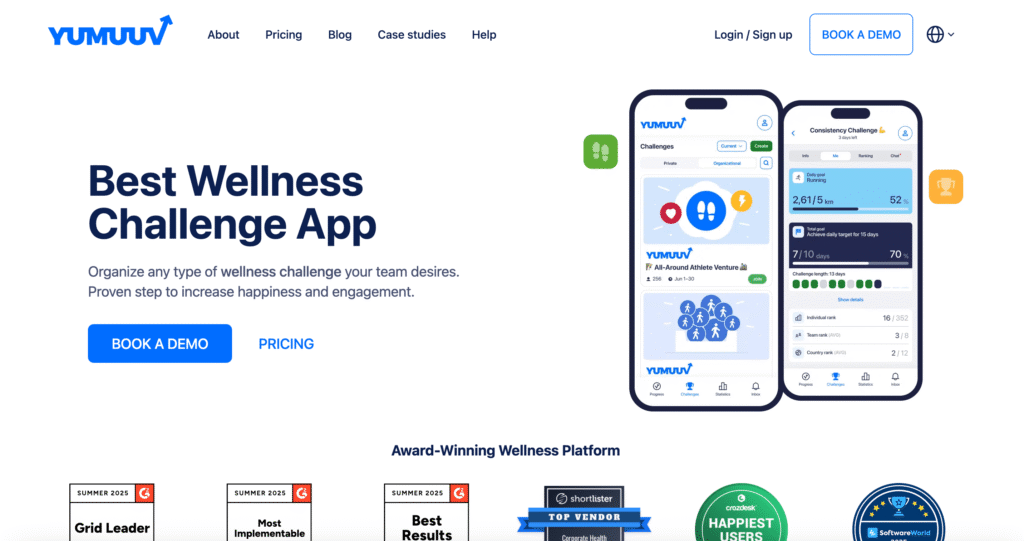
YuMuuv has distinguished itself as a leading corporate wellness software solution in 2025, garnering acclaim for its innovative focus on team-based wellness challenges that actively promote employee participation, accountability, and social connection. The platform’s core competency lies in fostering a vibrant and motivating environment through highly customizable, diverse wellness initiatives that align with organizational goals and individual preferences.
Customizable and Diverse Wellness Challenges
- Offers a broad spectrum of wellness challenges encompassing physical activity and holistic health, including step counts, sleep tracking, mindfulness, yoga, running, cycling, and hydration goals.
- Supports both team-oriented and company-wide challenges, allowing employers to design wellness programs tailored to their unique culture and wellness objectives.
- Enables employees to engage in fun, competitive, and inclusive activities, boosting motivation and collective health awareness.
Seamless Integration with Wearable Devices and Enhanced Engagement Tools
- Integrates smoothly with a wide range of popular wearable devices, including Fitbit, Apple Watch, Garmin, Polar, and Suunto, facilitating effortless and accurate activity data capture.
- Incorporates leaderboards that stimulate friendly competition among participants, enhancing motivation and ongoing engagement.
- Features an integrated chat system that encourages communication and camaraderie within teams, reinforcing social bonds critical to wellness adherence.
Global Accessibility and Personalized Support
- Provides multi-language support with availability in 37 languages, making it ideal for multinational organizations seeking to implement inclusive wellness programs across diverse geographies.
- Offers a dedicated personal success manager to guide onboarding and provide continuous assistance, ensuring smooth implementation and sustained user engagement.
- Enables co-branding opportunities, allowing companies to align the platform’s appearance with their corporate identity and enhance brand cohesion.
Industry Recognition and User Feedback
- Ranked #1 in both the Results Index and Implementation Index in the G2 Spring 2025 Reports, underscoring its excellence in delivering measurable wellness outcomes and ease of deployment.
- Exhibits a strong user adoption rate of 51%, reflecting substantial employee engagement and platform penetration.
- Achieves a 4.5 out of 5 rating on both Gartner (based on 18 reviews) and G2, indicating widespread user satisfaction.
- Users commend YuMuuv for its intuitive interface, customizable challenge options, robust team engagement features, and motivational impact on employee well-being.
- Some users have noted minor challenges such as occasional manual input requirements and synchronization delays, though these issues are generally infrequent and managed effectively.
Flexible and Scalable Pricing Models
- Annual wellness challenge plans are priced competitively at $3 per user per month, offering an accessible entry point for diverse organizations.
- The base annual package starts at $1,300 USD, with pricing scales accommodating from small teams (as low as $750 for up to 20 users) to large enterprises with over 50,000 users through custom pricing.
- Provides one-time project options beginning at $499, suitable for targeted or short-term wellness initiatives.
Distinctive Advantages and Strategic Market Position
- Emphasizes highly customizable, engaging team-based wellness challenges that foster social interaction and accountability, addressing the contemporary emphasis on community-driven health programs.
- Recognized for its effectiveness and straightforward implementation, as validated by leading industry benchmarks and user satisfaction indices.
- Supports broad device compatibility, ensuring precise tracking and seamless user experience across multiple fitness technologies.
- Offers a cost-efficient pricing structure suitable for organizations seeking scalable wellness solutions for both immediate and long-term initiatives.
Summary Matrix: YuMuuv Corporate Wellness Platform Overview
| Feature | Description |
|---|---|
| Wellness Challenges | Step, sleep, mindfulness, yoga, running, cycling, hydration |
| Engagement Tools | Team and company-wide challenges, leaderboards, integrated chat |
| Device Integration | Fitbit, Apple Watch, Garmin, Polar, Suunto |
| Global Support | Multi-language (37 languages), personal success manager |
| User Ratings | Gartner 4.5/5, G2 4.5/5; G2 #1 in Results and Implementation Index |
| Pricing | $3/user/month annual plans; One-time projects from $499; Custom pricing for >50,000 users |
| Target Market | Small to large enterprises with global teams |
| Unique Selling Points | Team focus, customization, ease of use, broad device integration |
In conclusion, YuMuuv’s dedicated approach to team-centric, customizable wellness challenges, combined with its proven effectiveness and flexible pricing, cements its status as one of the top corporate wellness software platforms in 2025. Its commitment to fostering social engagement within wellness programs aligns seamlessly with modern organizational priorities, making it an indispensable tool for enhancing employee health, motivation, and collaboration.
7. Wellness360
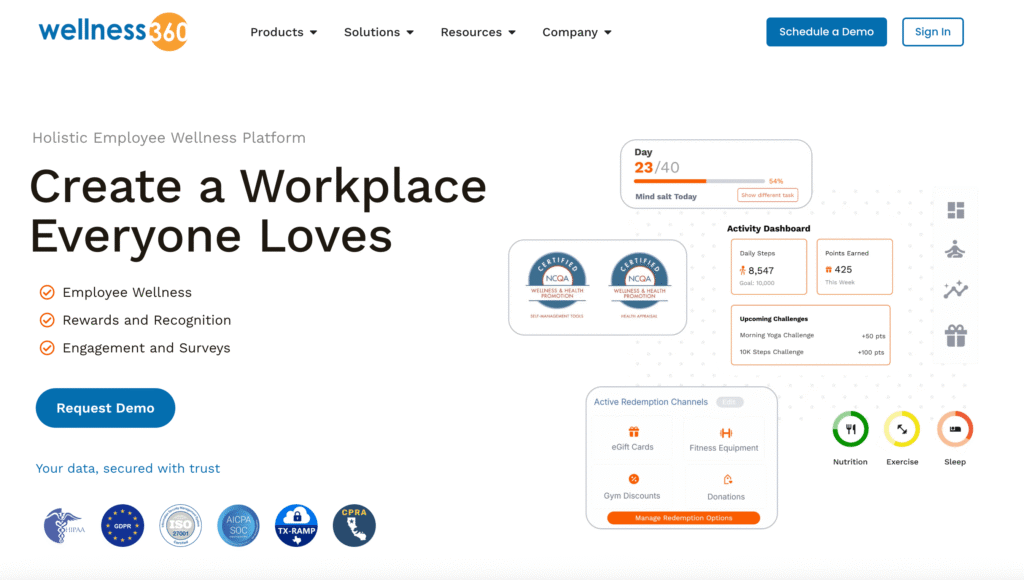
Wellness360 has emerged as a distinguished corporate wellness platform in 2025, acclaimed for its comprehensive and scalable approach to employee well-being. It excels by integrating peer support networks, customizable wellness challenges, and sophisticated health risk assessments, all underpinned by a strong commitment to data-driven insights. This multifaceted design positions Wellness360 as a strategic partner for organizations aiming to cultivate a healthier, more engaged workforce.
Peer Support and Community Building
- Facilitates the creation of peer support networks, encouraging social interaction and mutual encouragement among employees, which is critical in nurturing a positive workplace culture.
- Promotes connection and collaboration through features that enable employees to support one another, fostering emotional well-being alongside physical health.
Customizable Wellness Challenges and Activity Tracking
- Offers an extensive range of customizable wellness challenges, allowing organizations to tailor programs to their unique health goals and cultural dynamics.
- Supports activity tracking through seamless integration with a variety of wearable devices, ensuring accurate monitoring of fitness metrics and overall health behaviors.
- Incorporates gamification techniques to incentivize participation, motivating employees to meet personalized health objectives.
Health Risk Assessments and Personalized Goal Setting
- Provides comprehensive health risk assessments that empower employees to gain a clearer understanding of their current health status.
- Enables personalized goal-setting features that adapt to individual needs, encouraging sustainable lifestyle changes and proactive wellness management.
Data-Driven Insights and Engagement Analytics
- Emphasizes analytics and reporting capabilities that deliver actionable insights into program effectiveness, allowing organizations to optimize wellness strategies based on real data.
- Tracks employee engagement levels and health trends, supporting evidence-based decision-making and continuous improvement of wellness initiatives.
User Experience and Industry Recognition
- Achieves an outstanding rating of 4.9 out of 5 on G2, based on 46 user reviews, reflecting high levels of satisfaction and trust.
- Users consistently highlight the platform’s ability to connect teams, ease of integration with multiple devices, exemplary customer support, and adaptability to specific organizational needs.
- While feedback is predominantly positive, some users have noted occasional integration challenges and expressed interest in enhanced customization capabilities.
Pricing and Accessibility
- Offers a free trial to facilitate user evaluation and adoption.
- Pricing details are customized and available upon request, with some indications placing the annual cost near $6,000, making it accessible for a broad range of organizational sizes.
Unique Value Propositions and Market Position
- Distinctly emphasizes peer support as a central element of workplace wellness, aligning with contemporary trends that recognize social connections as pivotal to overall health.
- Demonstrates scalability to accommodate businesses of varying sizes, from small enterprises to large corporations.
- Utilizes a data-driven framework to continuously assess and enhance wellness program effectiveness, ensuring tangible outcomes.
- Customizable wellness programs enable alignment with diverse organizational cultures and strategic health objectives, increasing program relevance and impact.
Summary Matrix: Wellness360 Corporate Wellness Platform Overview
| Feature | Description |
|---|---|
| Peer Support Network | Facilitates employee social support and collaboration |
| Wellness Challenges | Customizable programs with gamification elements |
| Health Assessments | Comprehensive risk assessments and personalized goals |
| Device Integration | Supports multiple wearable devices for seamless tracking |
| User Ratings | G2 4.9/5 based on 46 reviews |
| Pricing | Free trial available; Annual pricing around $6,000 (custom) |
| Target Market | Scalable for small to large organizations |
| Unique Selling Points | Peer support focus, data-driven insights, customizable programs |
In conclusion, Wellness360’s holistic approach to corporate wellness, combining peer support with customizable challenges and data analytics, firmly establishes it as a top-tier solution in 2025. Its scalable design and ability to foster meaningful social connections within organizations align perfectly with modern workplace wellness priorities, making it an essential platform for enhancing employee health, engagement, and productivity.
8. Sprout (Telus Health Platform)
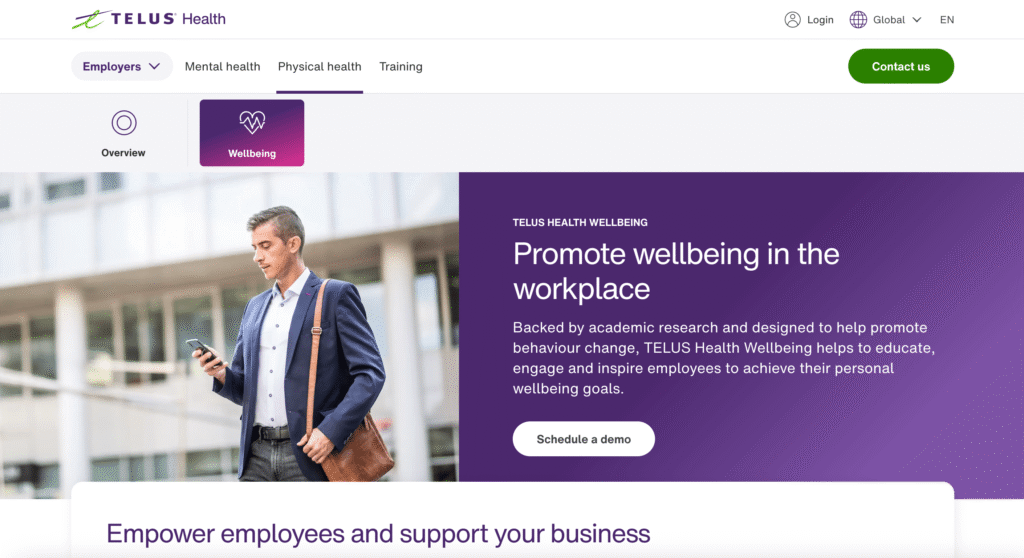
Sprout, a distinguished platform within the Telus Health ecosystem, has solidified its reputation as a premier corporate wellness software in 2025 by harnessing cutting-edge machine learning technology to deliver personalized health insights and proactively predict chronic disease risks. Its comprehensive approach to wellness integrates both physical and mental health dimensions, positioning Sprout as a transformative solution for organizations committed to advancing employee well-being through innovation and data-driven strategies.
Advanced Personalization through Machine Learning
- Employs sophisticated machine learning algorithms to curate and deliver highly personalized health content tailored to individual user needs and risk profiles.
- Utilizes predictive analytics to assess employees’ likelihood of developing chronic diseases, enabling early intervention and targeted wellness initiatives.
- Adapts continuously to user behavior and health data, enhancing the relevance and impact of wellness programming over time.
Holistic Wellness Ecosystem
- Supports an integrative model encompassing physical fitness, mental health, and nutritional well-being through a variety of virtual resources.
- Offers community challenges designed to foster motivation, enhance team cohesion, and build a culture of collective health engagement.
- Provides a rich suite of wellness activities, including webinars, guided meditation sessions, yoga classes, and personalized consultations, addressing diverse employee wellness needs.
Comprehensive Health Monitoring and Risk Management
- Enables employees to track vital health metrics such as physical activity levels and nutritional intake through an intuitive interface.
- Incorporates robust risk assessment tools that provide clear insights into individual health risks, facilitating informed decision-making and proactive management.
- Integrates gamification elements including leaderboards and rewards systems to drive sustained engagement and incentivize healthy behaviors.
Demonstrated Impact and User Satisfaction
- Empirical data reveals that 10% of Sprout users increase their daily steps by 27% and reduce their risk of type II diabetes by 52%, highlighting the platform’s tangible health benefits.
- Earns exceptional user feedback with a perfect 5 out of 5 rating on G2 and a recent 4.8 out of 5, reflecting widespread acclaim for its engaging content, personalized approach, and effective risk assessment capabilities.
- While lauded for its innovation and holistic wellness model, some users have cited premium pricing relative to competitors and noted areas for enhancement in employee reporting functionalities.
Pricing Structure and Related Offerings
- Sprout does not provide a free trial; pricing is bespoke and available upon direct consultation with the vendor.
- Associated product SproutStep focuses on alternative therapies, with pricing tiers ranging from $5 to $199.99 per employee per month, offering organizations additional avenues for wellness investment.
Unique Selling Propositions and Market Differentiators
- Pioneers the integration of machine learning to deliver dynamically personalized wellness content and predict chronic disease susceptibility, setting a new standard in corporate wellness technology.
- Emphasizes a holistic approach that equally prioritizes mental and physical health, aligning with contemporary wellness trends and employee expectations.
- Demonstrates measurable positive outcomes on user health metrics, reinforcing its effectiveness and return on investment for organizations.
Summary Matrix: Sprout (Telus Health) Corporate Wellness Platform
| Feature | Description |
|---|---|
| Personalization | Machine learning-driven personalized health content and analytics |
| Wellness Approach | Holistic—physical fitness, mental health, nutrition |
| Engagement Tools | Community challenges, gamification, webinars, meditation, yoga |
| Health Monitoring | Activity tracking, nutritional intake, risk assessment |
| User Ratings | G2 5/5, recent 4.8/5 |
| Pricing | Custom pricing; no free trial; SproutStep $5–$199.99/employee/month |
| Target Market | Organizations prioritizing advanced, data-driven wellness |
| Unique Selling Points | Machine learning innovation, holistic wellness, measurable impact |
In summary, Sprout’s pioneering application of machine learning, combined with its holistic wellness programming and data-driven impact, secures its position among the top corporate wellness platforms in 2025. Its ability to deliver personalized, actionable health insights and foster comprehensive employee engagement underscores its critical role in modern corporate health strategies.
9. Limeade
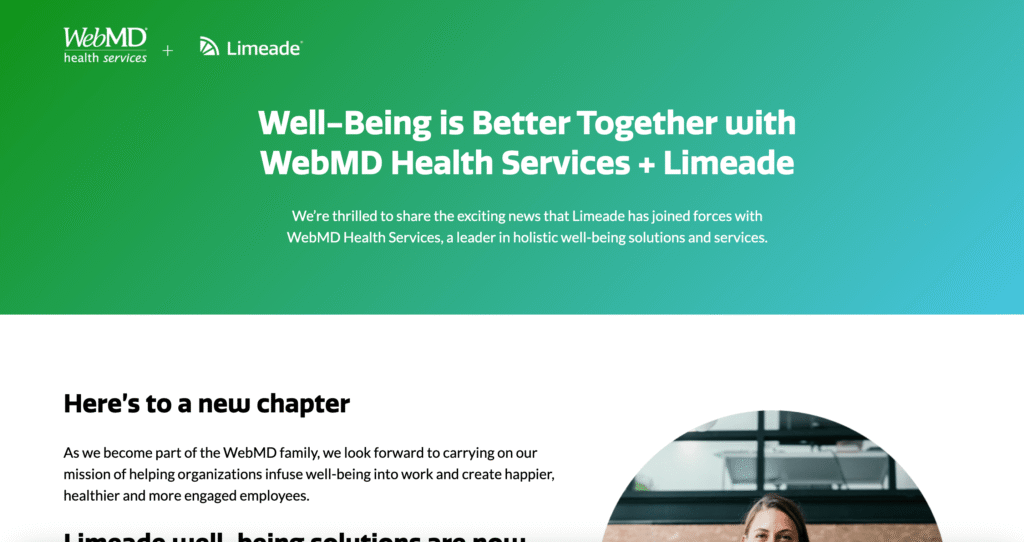
Limeade has established itself as a leading corporate wellness software in 2025, distinguished by its robust use of data-driven dashboards and personalized communication tools that collectively enhance employee engagement and foster a comprehensive culture of well-being. Its multifaceted platform integrates wellness, engagement, inclusion, and internal communications, offering organizations an advanced solution to improve the overall employee experience through actionable insights and targeted interventions.
Data-Driven Engagement and Personalized Communication
- Utilizes sophisticated, data-backed dashboards to monitor real-time employee engagement metrics, providing organizations with deep insights into workforce wellness trends and participation levels.
- Delivers personalized alerts and notifications designed to motivate employees, enhance their awareness, and sustain engagement throughout wellness programs.
- Offers real-time feedback mechanisms enabling employees to receive timely encouragement and organizations to adjust strategies responsively.
Comprehensive and Holistic Well-Being Framework
- Encompasses a broad spectrum of well-being domains, including physical health, mental resilience, and financial wellness, addressing the diverse needs of a modern workforce.
- Integrates tailored wellness programs that adapt to individual employee profiles, promoting sustained health improvements and personal growth.
- Functions as a centralized communication hub, facilitating seamless internal messaging and collaboration to reinforce wellness culture and inclusivity.
Integration Capabilities and User Experience
- Supports smooth integration with existing HR systems and third-party applications, enabling organizations to leverage current infrastructures while enriching wellness initiatives.
- Provides a user-friendly interface that encourages adoption and ease of navigation across diverse employee demographics and organizational structures.
- Allows for a degree of customization in wellness content and program delivery, though some users have noted limitations in the flexibility of smart notifications and email customization.
User Feedback and Performance Metrics
- Holds a G2 user rating of 4.3 out of 5, indicating overall positive reception in the corporate wellness community.
- Despite a reported Net Promoter Score of -55 and a Product Quality rating of 2.5 out of 5, Limeade achieves an enrollment rate of approximately 27%, with high satisfaction levels among participating employees.
- User reviews consistently praise Limeade for its ability to connect employees across departments, engaging content, and supportive wellness framework, while some highlight areas for improvement in notification customization and cross-departmental utilization.
Pricing Structure and Accessibility
- Adopts a custom pricing model tailored to the specific needs and scale of each organization, with pricing details available upon direct consultation with Limeade representatives.
Distinctive Strengths and Market Position
- Excels in delivering data-driven insights and personalized communication, enabling organizations to make informed decisions and foster ongoing employee motivation.
- Adopts a holistic approach that extends beyond traditional wellness offerings by incorporating mental health, financial well-being, and inclusive engagement strategies.
- Designed to support multicultural and diverse workforces, facilitating connection and inclusivity across global teams and varied organizational cultures.
Summary Matrix: Limeade Corporate Wellness Platform Overview
| Feature | Description |
|---|---|
| Engagement Tools | Data-backed dashboards, personalized alerts, real-time feedback |
| Wellness Scope | Holistic—physical, mental, financial well-being |
| Communication | Centralized internal communications and inclusivity features |
| Integration | Seamless HRIS and third-party application integration |
| User Ratings | G2 4.3/5; NPS -55; Product Quality 2.5/5; 27% enrollment |
| Pricing | Custom pricing model |
| Target Market | Organizations with diverse, multicultural workforces |
| Unique Selling Points | Data-driven insights, personalized communication, holistic approach |
In conclusion, Limeade’s distinctive focus on data analytics, personalized engagement, and holistic wellness strategies firmly establishes it as one of the top corporate wellness platforms in 2025. Its capabilities to support diverse organizational cultures and foster meaningful employee connections position Limeade as a valuable asset for companies seeking to enhance their employee well-being comprehensively and inclusively.
10. Virgin Pulse
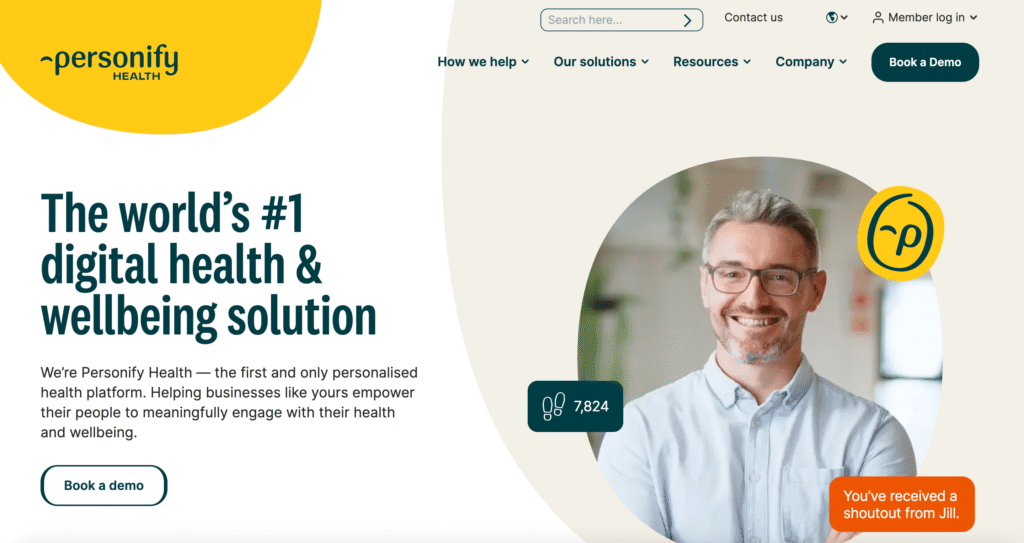
Virgin Pulse has firmly established itself as a premier global corporate wellness platform in 2025, distinguished by its expansive international reach and robust multilingual support, making it an ideal solution for multinational enterprises. The platform is purpose-built to drive sustained lifestyle and behavioral transformation among employees, delivering a comprehensive ecosystem that addresses a broad spectrum of wellness needs while fostering long-term engagement.
Global Accessibility and Multilingual Support
- Operates in 21 languages, ensuring accessibility and inclusivity for diverse, geographically dispersed workforces.
- Supports multinational organizations by accommodating cultural and regional differences in wellness preferences and communication styles.
Comprehensive Wellness Ecosystem
- Offers an extensive library of educational resources covering a wide range of health and wellness topics, empowering employees with knowledge to make informed lifestyle choices.
- Provides personalized wellness programs tailored to individual health profiles, fostering sustainable behavioral changes aligned with personal and organizational goals.
- Integrates gamification features such as challenges, leaderboards, and rewards systems to enhance motivation and sustained participation.
Advanced Tracking and Engagement Tools
- Facilitates detailed habit tracking and activity monitoring through seamless integration with popular wearable devices, capturing metrics related to physical activity, sleep, and other health parameters.
- Conducts thorough health risk assessments to identify potential concerns and tailor wellness interventions accordingly.
- Delivers benefits navigation and care management support to streamline employee access to health-related services and resources.
User Experience and Feedback Analysis
- Achieves an average rating of 4.3 out of 5 on G2, with users commending the platform’s intuitive interface and user-friendly design.
- Reports from TrustRadius present a balanced perspective: while some users appreciate Virgin Pulse’s innovative approach to employee wellness, others highlight challenges such as complexities in the points and rewards system and concerns over perceived mandatory usage.
- Common feedback praises the platform’s comprehensive feature set but also calls attention to the need for clearer communication and simplification of reward mechanisms.
Pricing Structure and Plan Options
- Employs a customizable pricing model tailored to the scale and specific wellness needs of organizations, emphasizing flexibility to accommodate different business sizes and sectors.
- Offers multiple program tiers including Kick-start, Go Challenge, Essential Wellbeing, and Complete Wellbeing, each featuring a distinct combination of services and corresponding investment levels.
Distinctive Strengths and Market Positioning
- Stands out for its unparalleled global footprint and multilingual capabilities, enabling corporations to deploy wellness programs consistently across international offices.
- Combines health promotion, well-being enhancement, and benefits navigation within a unified platform, providing a holistic solution that simplifies employee wellness management.
- Prioritizes the facilitation of long-term behavioral change, aligning with emerging corporate wellness trends that focus on sustainable health outcomes rather than short-term engagement spikes.
Summary Matrix: Virgin Pulse Corporate Wellness Platform
| Feature | Description |
|---|---|
| Global Reach | Supports 21 languages for multicultural, multinational workforces |
| Wellness Programs | Personalized, behavior-change focused initiatives |
| Engagement Features | Gamification, challenges, leaderboards, rewards |
| Tracking & Assessment | Habit tracking, wearable integration, health risk assessments |
| User Ratings | G2 average 4.3/5; mixed TrustRadius feedback |
| Pricing | Custom pricing with tiered plans (Kick-start to Complete Wellbeing) |
| Target Market | Multinational organizations with diverse employee populations |
| Unique Selling Points | Global accessibility, comprehensive wellness suite, behavior change focus |
In conclusion, Virgin Pulse’s extensive global accessibility, comprehensive and integrative wellness offerings, and dedication to fostering enduring behavioral change collectively position it among the elite corporate wellness platforms in 2025. Its ability to serve large, diverse organizations with scalable, personalized programs underscores its critical role in advancing workplace health on a global scale.
11. Microsoft Viva Insights
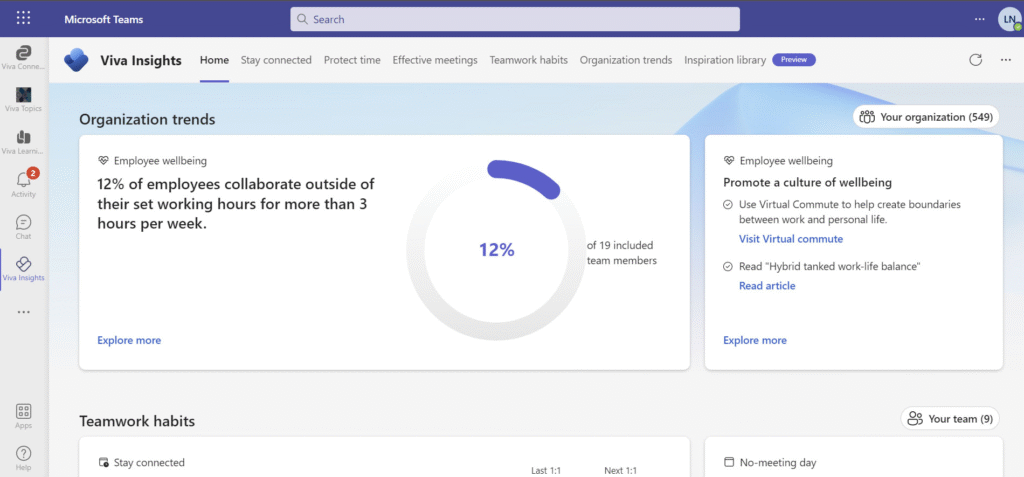
Microsoft Viva Insights has distinguished itself as a significant player in the corporate wellness software sector in 2025 by offering a data-driven approach centered on optimizing employee engagement and productivity through detailed analysis of work habits. As an integral component of the expansive Microsoft Viva suite, the platform leverages seamless integration with the ubiquitous Microsoft 365 ecosystem, delivering a uniquely embedded wellness solution that enhances employees’ work-life balance directly within their everyday digital environment.
Focused Analytics and Personalized Work Pattern Insights
- Provides employees with individualized feedback on their work behaviors, including metrics such as time spent in meetings, allocation of focus time, and frequency of after-hours work.
- Empowers users to identify areas for improvement in their daily routines, encouraging healthier habits that contribute to enhanced well-being and reduced burnout risks.
- Utilizes advanced data analytics to transform raw work data into actionable insights, facilitating organizational strategies aimed at boosting overall productivity while safeguarding employee health.
Integration within the Microsoft Ecosystem
- Seamlessly integrates with Microsoft 365 applications, including Outlook, Teams, and OneDrive, ensuring minimal disruption to existing workflows while maximizing user adoption.
- Enables organizations already invested in Microsoft’s environment to embed wellness initiatives naturally into daily operations without the need for additional platforms or interfaces.
- Supports both enterprise and mid-market segments evenly, reflecting its adaptability to varied organizational sizes and complexities.
User Reception and Market Position
- Holds a solid rating of 4.5 out of 5 stars on G2, based on 43 user reviews, signaling a generally positive reception and ease of use.
- Ranked as the 11th Easiest To Use Corporate Wellness software, underscoring its user-friendly design and accessibility within corporate contexts.
- Though detailed qualitative feedback is limited, the balanced client distribution (37% enterprise, 37% mid-market) highlights broad applicability and acceptance across diverse organizational scales.
Pricing Model and Accessibility
- Employs a customized pricing structure tailored to the specific needs and scale of each organization, with detailed pricing available through direct vendor consultation.
Distinctive Advantages and Unique Selling Propositions
- Stands apart due to its deep integration with Microsoft’s widely adopted productivity tools, providing wellness insights directly within the platforms employees use daily.
- Focuses uniquely on behavioral and productivity analytics as key drivers of employee well-being, expanding the traditional scope of corporate wellness beyond physical health alone.
- Embeds wellness considerations organically into the employee experience, making health-conscious decisions a natural part of work routines rather than an isolated program.
Summary Matrix: Microsoft Viva Insights Corporate Wellness Solution
| Feature | Description |
|---|---|
| Core Functionality | Personalized insights into work patterns and productivity |
| Ecosystem Integration | Full integration with Microsoft 365 applications |
| User Ratings | G2 rating 4.5/5; ranked 11th easiest to use |
| Client Segments | Balanced enterprise and mid-market representation (37% each) |
| Pricing | Custom pricing upon consultation |
| Unique Selling Points | Embedded wellness insights, behavioral analytics, Microsoft ecosystem synergy |
In conclusion, Microsoft Viva Insights leverages its unparalleled integration within the Microsoft 365 suite and its focus on data-driven behavioral insights to redefine corporate wellness in 2025. By embedding well-being directly into daily work practices and providing actionable feedback on work habits, it offers organizations a strategic and efficient tool to promote healthier, more productive work environments across diverse industries and organizational scales.
The Growing Importance of Corporate Wellness Programs
- The modern corporate landscape increasingly acknowledges employee well-being as a critical pillar of organizational success rather than a mere ancillary benefit.
- Well-being initiatives significantly influence key operational metrics, including workforce productivity, healthcare expenditure reduction, and enhancement of overall workplace morale.
- This paradigm shift reflects a movement away from viewing wellness programs as optional perks toward recognizing them as strategic imperatives integral to sustaining competitive advantage.
- Empirical research supports the tangible benefits of corporate wellness, demonstrating how stress reduction among employees contributes to decreased healthcare costs for companies.
- A substantial majority of enterprises, particularly in the United States—where approximately 80% of companies with more than 50 employees now offer wellness programs—have adopted these initiatives, signaling market maturity and widespread acceptance.
- This adoption trend highlights the escalating corporate commitment to fostering holistic employee wellness as a means to improve retention, engagement, and overall organizational performance.
Defining Corporate Wellness Software and Its Benefits
- Corporate wellness software comprises sophisticated digital platforms designed to streamline the planning, execution, and management of workplace wellness programs.
- These solutions provide infrastructure facilitating the orchestration of wellness activities, participant engagement tracking, progress monitoring, and rewards administration.
- The deployment of such software offers multifaceted benefits to organizations, notably reducing employee stress levels, which translates into long-term healthcare cost savings.
- Enhanced workforce health achieved through these platforms often results in heightened productivity, increased employee morale, and a positive impact on retention rates.
- From an employee perspective, wellness software empowers individuals by providing accessible tools and resources to improve mental, physical, and emotional health.
- This empowerment encourages informed decision-making and the adoption of healthier lifestyles, positively affecting employees’ quality of life both within the professional environment and beyond.
Scope and Objectives of This Report
- This report delivers an exhaustive analysis of the top 11 corporate wellness software solutions projected to lead the market in 2025.
- The primary focus is to elucidate the defining features and capabilities of these platforms in response to the evolving demands of corporate wellness strategies.
- Quantitative evaluations encompass software performance metrics, user satisfaction ratings, and relevant usage statistics to provide objective measures of effectiveness.
- Complementary qualitative assessments through sentiment analysis of user reviews offer nuanced insights into the strengths and limitations as perceived by end-users.
- Pricing structures and associated investment details are examined where accessible, enabling comparative evaluation of cost-efficiency and scalability.
- The report further highlights the unique selling propositions that set each platform apart, equipping organizations with critical knowledge to identify solutions optimally aligned with their wellness objectives and organizational culture.
- Target audiences for this analysis include human resource professionals, employee benefits administrators, corporate decision-makers, and wellness consultants engaged in the strategic design and execution of employee health initiatives.
Summary Table: Corporate Wellness Programs and Software Overview
| Aspect | Key Insights |
|---|---|
| Importance | Employee well-being as strategic imperative |
| Organizational Benefits | Productivity, reduced healthcare costs, employee engagement |
| Employee Benefits | Enhanced mental, physical, emotional health |
| Software Features | Activity management, participation tracking, rewards systems |
| Market Adoption | 80% of U.S. companies with 50+ employees offer wellness |
| Evaluation Criteria | Ratings, user sentiment, pricing, unique selling points |
| Intended Audience | HR leaders, benefits administrators, business executives |
This comprehensive examination underscores the critical role corporate wellness software plays in fostering healthier, more productive workplaces. By synthesizing data-driven insights with qualitative user feedback, this report empowers stakeholders to make informed decisions regarding the selection and implementation of corporate wellness solutions that will drive organizational success well into 2025 and beyond.
Key Trends Shaping Corporate Wellness in 2025: An In-Depth Analysis
Emphasis on Mental Health Support
- The corporate wellness landscape in 2025 is significantly influenced by an intensified focus on mental health, recognizing its critical role alongside physical well-being.
- Growing awareness among employees underscores this shift, with approximately 71% perceiving greater employer concern for mental health compared to previous years.
- Mental health support is now a decisive factor for 81% of employees when evaluating potential employers, driving organizations to integrate comprehensive mental health resources.
- These resources encompass access to therapy, mindfulness and stress reduction programs, and workshops designed to build resilience and coping skills.
- The widespread adoption of Employee Assistance Programs (EAPs) and virtual counseling services—offered by 97.8% and 94.8% of companies respectively—reflects corporate commitment to accessible, confidential mental health care.
- This strategic investment correlates with measurable benefits, including enhanced productivity and decreased absenteeism, confirming mental health as a foundational element of workplace wellness.
Financial Wellness Initiatives
- Financial wellness programs are increasingly recognized as essential components of holistic employee well-being strategies in 2025.
- Addressing financial stress is paramount due to its substantial impact on employee burnout, health, and job performance.
- Companies are implementing diverse initiatives such as financial literacy workshops, debt management support, and retirement planning services to improve financial stability.
- Personalized financial guidance is often available through access to professional advisors, facilitating tailored support for employees’ unique circumstances.
- Adoption rates are high, with 92.2% of organizations providing financial advisors and 91.4% conducting educational seminars, signifying the prioritization of financial health.
- By alleviating financial anxieties, organizations enhance employee focus, satisfaction, and overall workplace engagement, leading to improved business outcomes.
Flexible Work Arrangements and Their Impact
- Flexibility in work arrangements is a defining trend shaping corporate wellness, affording employees greater autonomy to balance professional and personal responsibilities.
- Remote and hybrid work models have gained mainstream acceptance, with 83% of organizations offering such options to their workforce.
- This flexibility mitigates stress and reduces fatigue related to commuting, thereby promoting better mental and physical health.
- Flexible arrangements contribute to higher productivity levels by fostering supportive, less stressful environments and serve as strategic levers for talent retention amid competitive labor markets.
The Role of Telemedicine
- Telemedicine integration within corporate wellness programs is transforming healthcare accessibility and efficiency for employees.
- Providing virtual medical consultations reduces barriers to care, shortens wait times, and lowers out-of-pocket expenses.
- Organizations benefit through reduced healthcare costs and improved employee health outcomes, reflecting a commitment to innovative, technology-driven health solutions.
- This trend exemplifies the broader adoption of digital health technologies aimed at optimizing care delivery regardless of employees’ geographic locations or schedules.
The Rise of Inclusive Wellness Programs
- Inclusion has become a pivotal consideration, with wellness programs evolving to address the diverse needs of a multifaceted workforce.
- Organizations are designing initiatives that accommodate variations in age, abilities, gender identity, cultural backgrounds, and neurodiversity.
- Inclusive programs promote health equity and foster a sense of belonging, which are linked to enhanced employee morale and productivity.
- Features of such programs include culturally relevant content, multilingual access, adaptable physical activities, and time zone-sensitive scheduling for global teams.
- Tailoring wellness offerings to diverse populations ensures higher engagement and effectiveness, reflecting the necessity of inclusivity in modern corporate wellness.
Personalization Through Data and Artificial Intelligence
- The utilization of advanced data analytics and AI enables the delivery of highly personalized wellness interventions tailored to individual employee profiles.
- Insights derived from biometric screenings, health assessments, wearable devices, and participation data allow organizations to customize programs addressing specific needs such as stress reduction or physical activity promotion.
- AI-driven predictive analytics facilitate dynamic program adjustments in response to evolving health trends within the workforce.
- This shift towards data-driven personalization enhances employee engagement and program efficacy, marking a departure from one-size-fits-all wellness initiatives.
Holistic Health Approaches
- Contemporary wellness models embrace a holistic perspective that integrates physical, mental, emotional, and financial well-being.
- Platforms offering comprehensive resources—ranging from mental health support and financial education to physical activity tracking—enable organizations to align wellness strategies with corporate culture and employee needs.
- Consolidated wellness platforms deliver a unified user experience, fostering increased participation and sustained behavioral change.
- This multidimensional approach reflects the understanding that employee well-being encompasses interconnected facets requiring coordinated care.
Gamification and Incentives
- Gamification strategies are increasingly employed to enhance engagement by transforming wellness activities into interactive and motivating experiences.
- Competitive elements such as leaderboards, team challenges, and real-time progress tracking encourage sustained participation.
- Incentives, including rewards like gift cards, additional paid time off, and public recognition, further drive motivation and commitment to wellness goals.
- Platforms that efficiently manage these gamified programs enable organizations to measure impact and maintain long-term employee involvement.
Integration of Wellness Platforms
- The demand for streamlined access to wellness resources has catalyzed the development of integrated platforms consolidating diverse wellness tools into a single interface.
- Such platforms improve user experience by providing centralized access to health resources, engagement programs, and communication channels.
- From an organizational perspective, integration facilitates unified data collection, enabling comprehensive analysis of wellness outcomes.
- Reduction in administrative complexity and vendor fatigue are additional benefits, allowing HR teams to focus on strategic wellness program enhancement.
- This holistic consolidation reflects the imperative to move beyond fragmented wellness solutions towards cohesive, user-centric systems.
Summary Matrix: Key Corporate Wellness Trends in 2025
| Trend | Description | Impact on Wellness Programs |
|---|---|---|
| Mental Health Support | Increased prioritization of mental health resources | Enhanced productivity, reduced absenteeism |
| Financial Wellness | Initiatives targeting financial literacy and stability | Improved focus, reduced burnout |
| Flexible Work | Adoption of remote/hybrid models | Reduced stress, improved work-life balance |
| Telemedicine | Virtual healthcare accessibility | Lower costs, timely care delivery |
| Inclusive Wellness | Programs tailored for diverse employee demographics | Greater engagement, health equity |
| Personalization & AI | Data-driven customized wellness interventions | Higher engagement, program effectiveness |
| Holistic Health | Integration of mental, physical, emotional, and financial health | Comprehensive well-being, sustained participation |
| Gamification & Incentives | Use of competition and rewards to motivate participation | Increased engagement, positive behavior change |
| Platform Integration | Unified access to wellness resources | Streamlined management, better data insights |
This comprehensive overview of 2025’s corporate wellness trends provides essential insights for organizations aiming to implement forward-thinking, effective wellness programs. By understanding and integrating these key trends, companies can foster healthier, more engaged, and productive workforces, positioning themselves for sustained success in an increasingly competitive and wellness-conscious business environment.
Comparative Analysis of the Top 11 Corporate Wellness Software in 2025: An In-Depth Perspective
Overview
This comparative analysis offers a comprehensive examination of the leading corporate wellness software platforms anticipated to dominate the market in 2025. The evaluation focuses on critical attributes such as core features, pricing models, user satisfaction ratings, global accessibility, and specialized wellness components including mental health support, financial wellness integration, gamification, and wearable device compatibility. This analysis serves as a strategic guide for organizations seeking to select a platform that aligns with their wellness objectives and employee needs.
Core Feature Comparison
- Wellable
- Offers highly customizable wellness challenges, rewards systems, fitness classes, webinars, personalized health coaching, benefits navigation, and clinical event verification.
- Provides a robust infrastructure to facilitate comprehensive wellness programming.
- Vantage Fit
- Delivers health challenges integrated with rewards, detailed activity tracking, mood monitoring, heart rate tracking, and nutrition logging.
- Focuses on holistic health monitoring with biometric capabilities.
- Headspace for Work
- Specializes in guided meditations, mindfulness exercises, sleepcasts, focus-enhancing music, and access to therapy and psychiatry services (primarily US-based).
- Emphasizes mental health and engagement tracking.
- Forma
- Facilitates management of customizable spending accounts including LSAs, HSAs, FSAs, and HRAs, supported by the Forma Store, debit card functionalities, claims administration, and HRIS integration.
- Distinguished by global support and financial wellness focus.
- Nectar
- Features wellness challenges, comprehensive mental health support, peer and managerial recognition systems, points-based rewards, internal communication tools, and an AI-powered writing assistant.
- Aims to enhance engagement and mental well-being through social recognition and innovative communication.
- YuMuuv
- Excels in customizable team-based challenges covering steps, sleep, mindfulness, and other wellness activities, complemented by wearable integration, leaderboards, chat functionalities, and multi-language support.
- Encourages team engagement and accountability with gamified, social wellness programs.
- Wellness360
- Combines a peer support network with customizable challenges, health risk assessments, activity tracking, communication tools, and gamification elements.
- Prioritizes scalable social support structures and data-driven wellness management.
- Sprout (Telus Health Platform)
- Employs AI-driven personalized content, community challenges, virtual wellness resources, health monitoring, personalized consultations, risk assessments, and gamification.
- Integrates advanced technology to tailor wellness experiences and predict health risks.
- Limeade
- Offers personalized wellness insights, real-time engagement tools, data-backed dashboards, personalized alerts, and functions as a communication hub supporting inclusive well-being programs.
- Supports multicultural workforces with comprehensive wellness integration.
- Virgin Pulse
- Provides extensive educational content, individualized wellness programming, gamification, wearable compatibility, habit tracking, health risk assessments, rewards systems, benefits navigation, care management, and multilingual support.
- Emphasizes global reach and long-term behavioral change.
- Microsoft Viva Insights
- Delivers actionable insights into employee work habits to foster healthier work-life balance, improve engagement, and boost productivity through seamless integration with Microsoft 365 applications.
- Focuses on embedding wellness within daily workflows.
Pricing Structure Overview
- Wellable: Starting at $75 per month, offering a scalable solution for varying organizational sizes.
- Vantage Fit: One-time fee starting at $1,500, suitable for companies preferring upfront investment.
- Headspace for Work: Priced at $7.50 per user monthly, focusing on accessible mental health resources.
- Forma: Employs custom pricing tailored to client needs, reflective of its specialized financial wellness features.
- Nectar: Affordable starting price of $2.75 per user monthly, emphasizing social engagement and mental health.
- YuMuuv: Starts at $3 per user monthly, offering cost-effective team challenge solutions.
- Wellness360: Custom pricing model reflecting its scalable and comprehensive platform.
- Sprout: Pricing available upon vendor contact; associated product SproutStep ranges from $5 to $199.99 per employee monthly.
- Limeade: Custom pricing, with flexibility based on enterprise requirements and user base size.
- Virgin Pulse: Customized pricing reflective of its extensive features and global reach.
- Microsoft Viva Insights: Pricing upon request, generally bundled with Microsoft 365 subscriptions.
User Ratings and Market Reception
- G2 and Gartner ratings reflect high user satisfaction across most platforms, with Wellness360 and Sprout achieving near-perfect scores (4.9/5 and 5.0/5 respectively on G2).
- Platforms like Wellable and Nectar also score above 4.5, indicating strong market approval.
- Microsoft Viva Insights and Virgin Pulse maintain solid ratings above 4.3, supported by their widespread corporate adoption.
Global Reach and Specialized Wellness Focus
- All platforms demonstrate global accessibility, with many supporting multi-language capabilities to serve multinational workforces.
- Mental health support is robustly integrated into most platforms, especially Headspace for Work, Nectar, Wellness360, and Sprout.
- Financial wellness is a notable feature in Forma, Limeade, and Wellable, addressing a growing trend in holistic employee support.
- Gamification remains a common engagement strategy, effectively utilized by Wellable, YuMuuv, Limeade, Virgin Pulse, and Sprout.
- Wearable integration is widespread, enabling seamless tracking of physical activity and health metrics, present in Wellable, Vantage Fit, YuMuuv, Wellness360, Sprout, Limeade, and Virgin Pulse.
Matrix: Feature Comparison of Top 11 Corporate Wellness Software Platforms in 2025
| Software | Custom Challenges | Mental Health Focus | Financial Wellness | Gamification | Wearable Integration | Pricing Model | G2 Rating | Global Reach |
|---|---|---|---|---|---|---|---|---|
| Wellable | Yes | Yes | Yes | Yes | Yes | Subscription ($75/mo) | 4.7/5 | Yes |
| Vantage Fit | Yes | Yes | No | No | Yes | One-time ($1,500) | 4.5/5 | Yes |
| Headspace for Work | No | Strong | No | No | No | Per User ($7.50/mo) | 4.6/5 | Yes |
| Forma | No | Yes | Yes | No | No | Custom Pricing | 4.8/5 | Yes |
| Nectar | Yes | Yes | No | No | No | Per User ($2.75/mo) | 4.7/5 | Yes |
| YuMuuv | Yes | Yes | No | No | Yes | Per User ($3/mo) | 4.5/5 | Yes |
| Wellness360 | Yes | Yes | No | No | Yes | Custom Pricing | 4.9/5 | Yes |
| Sprout | Yes | Yes | No | No | Yes | Contact Vendor | 5.0/5 | Yes |
| Limeade | No | Yes | Yes | Yes | Yes | Custom Pricing | 4.3/5 | Yes |
| Virgin Pulse | Yes | Yes | Yes | Yes | Yes | Custom Pricing | 4.3/5 | Yes |
| Microsoft Viva Insights | No | Yes | Yes | No | No | Contact Vendor | 4.5/5 | Yes |
Conclusion
The corporate wellness software landscape in 2025 is marked by diverse offerings tailored to meet the multifaceted needs of modern workforces. Platforms that combine customizable wellness challenges, robust mental health support, financial wellness features, gamification, and wearable integration demonstrate a competitive advantage. Organizations should weigh these features alongside pricing structures and global accessibility to identify solutions that best align with their wellness strategies. This detailed comparative analysis empowers HR leaders and decision-makers to make informed choices that foster employee well-being, engagement, and organizational success.
Factors to Consider When Selecting Corporate Wellness Software: A Detailed Guide for 2025
Organizational Size and Specific Requirements
- Organizational scale critically influences software suitability. Multinational enterprises benefit from platforms like Virgin Pulse, renowned for its extensive global reach, multilingual capabilities, and compliance with diverse regulatory frameworks.
- Large corporations require wellness software capable of managing complex administrative demands and catering to culturally diverse workforces distributed across multiple time zones.
- Small to medium-sized enterprises (SMEs) often prioritize affordability and ease of deployment, making platforms such as Nectar and YuMuuv attractive due to their flexible pricing and intuitive interfaces.
- Organizations with significant remote or hybrid workforces must consider software offering robust virtual engagement tools, multi-device accessibility, and interactive challenges to maintain connectivity and participation.
- Wellness objectives, whether focusing on mental health enhancement or physical activity promotion, should guide software selection, favoring platforms with specialized features aligned to these priorities.
Budgetary Considerations
- Financial planning is pivotal in selecting corporate wellness software, as costs can vary widely depending on program scope, feature sets, and participant volume.
- Pricing models range from subscription-based per-user fees to one-time purchases and customized enterprise agreements, requiring thorough evaluation.
- Additional expenses may arise from setup fees, premium modules such as biometric screenings or personalized coaching, and incentive management costs.
- Empirical studies suggest that investing approximately $100 to $150 annually per participant (excluding incentives) often correlates with effective engagement and measurable returns on investment.
- Organizations must align budgetary parameters with strategic wellness goals to secure software that balances cost-efficiency and comprehensive functionality.
Integration with Existing Human Resources Systems
- Seamless interoperability between wellness software and existing Human Resources Information Systems (HRIS), benefits management platforms, and payroll systems is critical for operational efficiency.
- Automated synchronization of employee data reduces manual administrative burden, ensuring accuracy in participation tracking and program management.
- Integration with benefits administration facilitates streamlined delivery of wellness-related perks such as gym reimbursements or health savings account allocations.
- Preference should be given to software offering robust Application Programming Interfaces (APIs) or pre-configured connectors compatible with prevalent HR technologies.
- Effective integration enhances user experience, promotes data cohesion, and supports comprehensive reporting and analytics.
Employee Demographics and Engagement Preferences
- A nuanced understanding of workforce demographics enables tailored wellness program implementation that resonates across diverse employee segments.
- Considerations include age distribution, wellness interests (e.g., physical fitness, mental health, financial literacy), and preferred engagement channels (mobile applications, web portals, social media features).
- Younger, tech-savvy employees may gravitate towards gamified challenges and mobile-first experiences, whereas a broader age spectrum might require varied activity options and accessibility accommodations.
- Collecting employee input through surveys or focus groups provides invaluable data to inform platform selection and feature prioritization.
- Alignment with employee preferences directly correlates with increased participation rates and program efficacy.
Targeted Wellness Focus Areas
- Organizations should assess and prioritize specific wellness domains based on workforce health assessments and organizational objectives.
- Mental health support platforms offering guided meditation, stress management resources, and access to counseling are crucial for addressing workplace stress and burnout.
- Physical wellness initiatives emphasizing activity tracking, competitive challenges, and wearable device integration effectively combat sedentary lifestyles.
- Financial wellness solutions providing budgeting tools, debt counseling, and retirement planning address a growing concern impacting employee productivity and satisfaction.
- Selecting software with specialized modules and resources aligned to these targeted areas ensures relevance and maximizes positive health outcomes.
Reporting and Analytical Capabilities
- Comprehensive reporting functionalities are indispensable for measuring program impact, engagement levels, and health outcomes.
- Key performance indicators such as participation rates, progress toward wellness goals, and resource utilization should be readily accessible through customizable dashboards.
- Visual analytics facilitate identification of trends and inform strategic adjustments to optimize program effectiveness.
- Flexible report generation caters to the informational needs of diverse stakeholders including HR teams, executive leadership, and employees themselves.
- Leveraging data analytics supports demonstration of return on investment and continuous program refinement.
User Experience and Mobile Accessibility
- Intuitive user interfaces that minimize complexity encourage higher adoption and sustained engagement across employee populations.
- Mobile compatibility is essential given the prevalence of remote work and the demand for wellness access beyond traditional office settings.
- Well-designed mobile applications complemented by responsive web platforms provide employees with on-the-go access to wellness activities and resources.
- Positive user experiences characterized by seamless navigation and device versatility significantly contribute to the overall success of wellness initiatives.
Summary Table: Key Factors in Corporate Wellness Software Selection
| Factor | Key Considerations | Impact on Selection |
|---|---|---|
| Organizational Size & Needs | Scale, geographic spread, cultural diversity | Determines software scalability and feature complexity |
| Budget | Pricing models, total cost of ownership | Influences affordability and program scope |
| Integration Capabilities | Compatibility with HRIS, benefits, payroll | Ensures operational efficiency and data accuracy |
| Employee Demographics & Preferences | Age, interests, technology use | Drives engagement and participation |
| Wellness Focus Areas | Mental health, physical activity, financial wellness | Aligns platform features with strategic objectives |
| Reporting & Analytics | KPI tracking, dashboards, customizable reports | Facilitates program evaluation and ROI measurement |
| User-Friendliness & Mobile Access | Interface design, mobile apps, cross-device functionality | Enhances adoption and consistent usage |
By methodically considering these critical factors, organizations can strategically select corporate wellness software solutions that not only address their unique challenges but also foster a culture of sustained employee well-being and organizational performance in 2025.
Recommendations for Selecting Corporate Wellness Software in 2025: An In-Depth Perspective
Overview of Leading Solutions
- The 2025 corporate wellness software market offers an expansive selection of advanced platforms, each distinguished by unique features tailored to meet the dynamic needs of modern organizations and their diverse employee populations.
- Wellable is renowned for its comprehensive, holistic approach and exceptional user satisfaction ratings, making it ideal for organizations of varying sizes seeking highly customizable wellness solutions.
- Vantage Fit leverages gamification and reward mechanisms effectively, making it especially attractive to enterprises aiming to boost employee motivation through interactive challenges and incentive programs.
- Headspace for Work remains a top-tier option for organizations placing mental health at the forefront, offering scientifically validated mindfulness practices, meditation guides, and mental well-being resources.
- Forma differentiates itself through its emphasis on flexible benefits, allowing employees to manage personalized spending accounts encompassing lifestyle, health savings, and wellness expenditures.
- Nectar excels in fostering a positive corporate culture by integrating robust employee recognition and rewards features that enhance engagement via appreciation and peer acknowledgment.
- YuMuuv specializes in orchestrating team-based physical activity challenges, thereby promoting employee health while simultaneously strengthening interpersonal connections within teams.
- Wellness360 offers a scalable, data-driven platform emphasizing peer support networks, making it suitable for organizations seeking community-oriented wellness solutions backed by analytics.
- Sprout (Telus Health) harnesses advanced machine learning technologies to deliver personalized wellness content, risk assessments, and tailored interventions, ideal for companies pursuing a technologically sophisticated and integrated approach.
- Limeade focuses on uniting well-being, engagement, inclusion, and communications within a single data-centric platform, enhancing the overall employee experience and organizational culture.
- Virgin Pulse provides a robust global wellness solution, well-equipped for multinational enterprises requiring multilingual support and an extensive feature set addressing holistic wellness needs.
- Microsoft Viva Insights integrates seamlessly within the Microsoft 365 ecosystem, delivering actionable insights into work patterns, fostering work-life balance, and appealing to organizations already invested in Microsoft technologies.
Strategic Alignment Based on Organizational Profiles
- Small and medium-sized enterprises with a pronounced emphasis on mental health initiatives may find Headspace for Work an excellent foundational choice, combining accessibility with evidence-based resources.
- Companies prioritizing employee engagement through recognition and reward mechanisms would benefit from considering Nectar for its user-centric design and motivational features.
- Organizations seeking comprehensive, customizable wellness platforms with a strong focus on physical activity and team engagement are likely to find Wellable or YuMuuv highly effective.
- Large-scale, multinational corporations requiring extensive global capabilities and multilingual accessibility should evaluate Virgin Pulse and Limeade as primary candidates due to their broad reach and diverse feature portfolios.
- Enterprises already deeply embedded within the Microsoft infrastructure may discover Microsoft Viva Insights as a seamless extension to promote well-being while capitalizing on existing workflows and data integration.
Future Outlook and Emerging Trends
- The corporate wellness software market is poised for continued expansion, propelled by heightened recognition of employee well-being as a critical strategic asset.
- Anticipated advancements include greater utilization of artificial intelligence for hyper-personalized wellness interventions, predictive analytics to preempt health risks, and enhanced preventive care features integrated into platforms.
- The integration of mental and financial wellness resources within unified platforms will likely deepen, reflecting a holistic understanding of employee health.
- Inclusivity and accessibility will remain at the forefront of innovation, with software solutions increasingly designed to cater to diverse workforce demographics, including neurodiverse populations, remote employees, and multicultural teams.
- Organizations investing strategically in corporate wellness technology in 2025 will be better positioned to cultivate healthier, more engaged, and productive employees, thereby strengthening overall organizational performance and resilience.
Summary Table: Recommendations Based on Organizational Needs
| Organization Type | Recommended Software | Key Strengths | Primary Wellness Focus |
|---|---|---|---|
| Small to Medium Businesses | Headspace for Work, Nectar | Mental health focus, user-friendly, engagement | Mental health, employee recognition |
| Mid to Large Enterprises | Wellable, YuMuuv | Customizable, gamification, team challenges | Physical activity, team engagement |
| Multinational Corporations | Virgin Pulse, Limeade | Global reach, multilingual support, comprehensive | Holistic wellness, inclusion, global workforce |
| Microsoft Ecosystem Users | Microsoft Viva Insights | Seamless Microsoft 365 integration, data-driven | Work-life balance, productivity insights |
| Tech-Savvy Organizations Seeking AI | Sprout (Telus Health) | Machine learning personalization, risk assessment | Personalized wellness, predictive analytics |
This comprehensive evaluation underscores the importance of aligning corporate wellness software selection with organizational scale, workforce demographics, wellness priorities, and technological infrastructure. By doing so, businesses can maximize the benefits of wellness programs, foster sustainable employee health, and drive long-term success in an increasingly competitive and health-conscious corporate landscape.
Conclusion
In conclusion, the landscape of corporate wellness software in 2025 has evolved into a dynamic and essential component of modern organizational strategy, reflecting a profound shift towards prioritizing employee well-being as a driver of productivity, engagement, and overall business success. The top 11 corporate wellness platforms examined in this in-depth analysis exemplify the diverse and sophisticated capabilities now available to organizations of all sizes and industries. From highly customizable, data-driven solutions like Wellable and Limeade to mental health-focused platforms such as Headspace for Work, these software tools are designed to address the multifaceted needs of today’s workforce.
As companies continue to navigate increasingly complex work environments marked by remote work, global teams, and diverse employee demographics, the importance of selecting the right wellness software cannot be overstated. Each platform reviewed offers unique strengths—whether it be gamification and rewards systems that boost engagement, robust integration with existing HR infrastructures, or comprehensive support for mental, physical, and financial well-being. Multinational corporations will find value in solutions like Virgin Pulse that provide extensive multilingual support and global reach, while enterprises embedded in the Microsoft ecosystem may benefit from the seamless integration offered by Microsoft Viva Insights.
The strategic implementation of corporate wellness software not only promotes healthier lifestyles but also contributes to reduced healthcare costs, lower absenteeism, and enhanced employee retention. Additionally, the integration of emerging technologies such as artificial intelligence and machine learning promises to further personalize and optimize wellness initiatives, making programs more effective and responsive to individual employee needs. The growing emphasis on inclusive, accessible, and holistic wellness programs reflects an understanding that employee well-being encompasses physical health, mental resilience, financial stability, and social connection.
For HR leaders, business executives, and benefits administrators, this comprehensive analysis serves as a crucial guide for navigating the myriad options in the corporate wellness software market. By carefully evaluating organizational size, budgetary considerations, employee preferences, and specific wellness priorities, decision-makers can select solutions that align closely with their corporate culture and strategic objectives. Investing in the right wellness technology today positions organizations to foster a motivated, healthier, and more productive workforce capable of meeting the challenges of the future workplace.
Looking ahead, the corporate wellness software industry is expected to continue its rapid advancement, driven by innovation and an expanding recognition of well-being as a cornerstone of sustainable business success. Organizations that proactively embrace these tools and integrate them effectively within their broader human capital strategies will not only enhance employee satisfaction and performance but also secure a competitive advantage in attracting and retaining top talent. Ultimately, the comprehensive adoption of advanced wellness platforms in 2025 marks a pivotal step toward cultivating resilient, engaged, and thriving workforces prepared for the demands of tomorrow’s evolving corporate landscape.
We, at the 9cv9 Research Team, strive to bring the latest and most meaningful data, guides, and statistics to your doorstep.
To get access to top-quality guides, click over to 9cv9 Blog.
To hire top talents using our modern AI-powered recruitment agency, find out more at 9cv9 Modern AI-Powered Recruitment Agency.
People Also Ask
What is corporate wellness software?
Corporate wellness software is a digital platform designed to help organizations manage employee health programs, track participation, and promote overall well-being through personalized activities, challenges, and health resources.
Why is corporate wellness software important in 2025?
In 2025, wellness software plays a critical role in improving employee productivity, reducing healthcare costs, and enhancing engagement by offering tailored wellness programs that address mental, physical, and financial health.
Which are the top corporate wellness software platforms in 2025?
The top platforms include Wellable, Vantage Fit, Headspace for Work, Forma, Nectar, YuMuuv, Wellness360, Sprout, Limeade, Virgin Pulse, and Microsoft Viva Insights.
How does corporate wellness software improve employee engagement?
These platforms use gamification, personalized content, rewards, and social challenges to motivate employees, fostering sustained participation and a positive health culture in the workplace.
What features should I look for in corporate wellness software?
Look for features like personalized wellness programs, mental health support, integration with wearables, data analytics, rewards systems, communication tools, and seamless HR system integration.
Can corporate wellness software support mental health?
Yes, many platforms provide resources like mindfulness exercises, virtual counseling, stress management tools, and Employee Assistance Programs to promote mental well-being.
How do wellness software platforms handle data privacy?
Top wellness platforms comply with data protection regulations, using encryption and anonymized data to ensure employee health information is secure and confidential.
Are corporate wellness platforms customizable?
Most leading solutions offer customization options for wellness challenges, content, rewards, and communication to align with company culture and employee preferences.
Do wellness platforms integrate with wearable devices?
Yes, many platforms sync with popular wearables to track physical activity, sleep, heart rate, and other health metrics to provide personalized insights.
What is gamification in corporate wellness software?
Gamification involves using game-like elements such as points, leaderboards, and rewards to increase engagement and encourage healthy behaviors among employees.
How do corporate wellness software platforms support remote employees?
These platforms offer mobile access, virtual challenges, webinars, and remote health monitoring to keep remote teams engaged regardless of location.
What role does AI play in corporate wellness software?
AI enables personalized content delivery, predictive health risk assessments, and tailored recommendations to enhance employee participation and health outcomes.
Can corporate wellness software help reduce healthcare costs?
Yes, by promoting healthier lifestyles and early risk detection, these platforms help reduce medical claims and overall healthcare expenses.
How do companies measure the success of wellness programs?
Success is measured using metrics like participation rates, health improvements, employee feedback, productivity changes, and ROI from reduced absenteeism.
Are financial wellness features included in corporate wellness software?
Many platforms now incorporate financial literacy tools, budgeting workshops, and access to financial advisors to address employees’ financial stress.
What is the average cost of corporate wellness software?
Costs vary widely depending on features and scale but typically range from a few dollars per user per month to custom enterprise pricing.
Can corporate wellness software be integrated with existing HR systems?
Yes, most top platforms offer API integrations with HRIS, payroll, and benefits management systems to streamline administration.
How do corporate wellness programs support diversity and inclusion?
Inclusive wellness programs provide multilingual content, address diverse health needs, and create accessible resources for all employees.
What are the benefits of a holistic wellness approach in software?
Holistic platforms address physical, mental, emotional, and financial health, promoting comprehensive well-being for sustained employee engagement.
Which software is best for mental health support?
Headspace for Work is highly regarded for mental health resources, including guided meditations and therapy access.
How do wellness platforms use challenges to engage employees?
Challenges encourage friendly competition and teamwork, increasing motivation through step counts, fitness contests, and wellness goals.
What reporting tools do top corporate wellness platforms offer?
They provide dashboards and analytics to track participation, health improvements, and program impact, helping organizations optimize wellness strategies.
How accessible are corporate wellness platforms on mobile devices?
Most leading platforms offer fully functional mobile apps to support anytime, anywhere access for increased employee convenience.
Can wellness software help with work-life balance?
Yes, tools like Microsoft Viva Insights analyze work habits and suggest improvements to promote healthier work-life integration.
Do wellness platforms offer rewards and incentives?
Many platforms incorporate rewards such as gift cards, PTO, and recognition programs to boost employee motivation and participation.
What makes Virgin Pulse suitable for multinational companies?
Its extensive global reach, multilingual support, and comprehensive wellness features make it ideal for diverse, international workforces.
How does Sprout utilize machine learning in wellness?
Sprout employs machine learning to deliver personalized content and predict chronic disease risk, enhancing preventive care efforts.
Are there platforms focusing on team-based wellness?
Yes, platforms like YuMuuv and Wellable specialize in team challenges to foster collaboration and group engagement.
What future trends will shape corporate wellness software beyond 2025?
Trends include deeper AI personalization, enhanced mental and financial wellness integration, telemedicine expansion, and increased focus on inclusivity.
How should companies choose the right corporate wellness software?
Selection should consider organizational size, budget, wellness priorities, employee demographics, integration needs, and reporting capabilities.
What is corporate wellness software?
Corporate wellness software is a digital platform designed to help organizations manage and implement employee health and wellness programs, offering features like activity tracking, challenges, health assessments, and rewards to promote healthier lifestyles.
Why is corporate wellness software crucial in 2025?
In 2025, corporate wellness software is vital for boosting employee productivity, reducing healthcare costs, and enhancing engagement by providing comprehensive, personalized wellness initiatives addressing physical, mental, and financial health.
Which are the top corporate wellness software platforms in 2025?
Leading platforms include Wellable, Vantage Fit, Headspace for Work, Forma, Nectar, YuMuuv, Wellness360, Sprout, Limeade, Virgin Pulse, and Microsoft Viva Insights, each offering unique wellness features and benefits.
How does corporate wellness software enhance employee engagement?
These platforms use gamification, personalized content, social challenges, and rewards to motivate employees, fostering sustained participation and a positive health culture in the workplace.
What essential features should I look for in corporate wellness software?
Key features include customizable wellness programs, mental health resources, wearable integration, data analytics, incentive management, communication tools, and seamless HR system integration.
Do corporate wellness platforms support mental health?
Yes, many provide mindfulness programs, virtual counseling, stress management resources, and Employee Assistance Programs to comprehensively address mental well-being.
How do wellness platforms ensure data privacy?
Top solutions comply with global data protection laws, employing encryption and anonymization techniques to safeguard sensitive employee health information.
Are corporate wellness software platforms customizable?
Most offer extensive customization options to tailor challenges, content, communication, and rewards, aligning with organizational culture and employee needs.
What is corporate wellness software?
Corporate wellness software is a digital platform designed to help organizations manage and implement employee health and wellness programs through features like activity tracking, challenges, assessments, and rewards to promote healthier lifestyles.
Sources
Trypicnic
WellSteps
Woliba
PDHI (White-label Digital Health Solutions)
Folio3 Digital Health
Terryberry
G2
Info-Tech Research Group
Workhuman
IncentFit
Headspace for Employers
Strive Well-Being
Vitality Works
Wellness360
Vantage Fit
YuMuuv
CoreHealth
Slashdot
Software Suggest
SaaSworthy
Shortlister
TrustRadius
People Managing People
Wellable
Microsoft Viva Insights
Meditopia
Verizon Benefits
SourceForge
Adamosoft
MyShortlister
Gartner
Payentry
Goodhue County Government
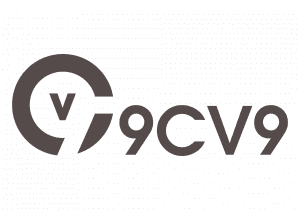
























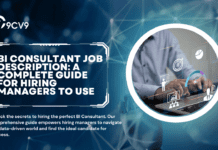





![Writing A Good CV [6 Tips To Improve Your CV] 6 Tips To Improve Your CV](https://blog.9cv9.com/wp-content/uploads/2020/06/2020-06-02-2-100x70.png)


